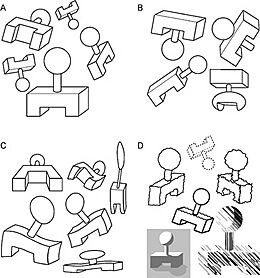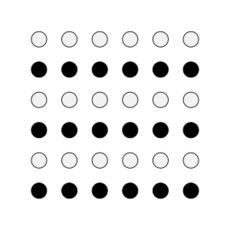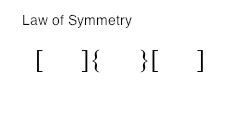Gestalt psychology facts for kids
Gestalt psychology is a way of thinking about how we see and understand the world. It focuses on how our brains process entire patterns and shapes, rather than just tiny pieces. Imagine looking at a picture: Gestalt psychology says you see the whole picture first, not just individual dots or lines.
This idea started in Austria and Germany in the early 1900s. It was a different way of looking at psychology compared to earlier ideas that tried to break down everything into its smallest parts.
A famous saying in Gestalt psychology is: "The whole is other than the sum of its parts." This means that when you put pieces together, the complete picture is often more than just those pieces added up. For example, a melody is more than just a collection of notes; it's the way they fit together. The German word Gestalt means "form," "pattern," or "configuration."
It's important to know that Gestalt psychology is different from Gestalt therapy. Gestalt therapy is a type of counseling, and it's only a little bit connected to Gestalt psychology.
Contents
How Gestalt Psychology Started
Gestalt psychology was founded by three main thinkers: Max Wertheimer, Kurt Koffka, and Wolfgang Köhler. This was in the early 20th century.
Before them, many psychologists believed in something called "structuralism." This idea was like trying to understand a building by only looking at each brick separately. They thought all knowledge came from simple feelings or "sensations" that were then linked together.
But the Gestalt psychologists disagreed. They believed that trying to break down our thoughts and feelings into tiny pieces wouldn't help us understand how our minds work. Instead, they saw our minds as understanding things in organized, complete ways. They argued that the "whole" picture is what's most important, and the parts get their meaning from being part of that whole.
Early Ideas of Gestalt
The idea of "Gestalt" was first talked about by a philosopher named Christian von Ehrenfels in 1890. He noticed that when you hear a melody or see a shape, it's more than just the individual sounds or lines. He called this extra quality Gestalt-qualität, or "form-quality." It's why you can still recognize a song even if it's played in a different key with different notes.
Max Wertheimer took this idea further in 1912. He did experiments where people saw lights flashing quickly. He found that people didn't just see two separate lights; they saw the illusion of movement between them. He called this the phi phenomenon. Wertheimer said that we see the "Gestalt" (the whole pattern or movement) first. For example, you hear the melody of a song first, and only then might you notice the individual notes.
Key Researchers and Their Work
Wolfgang Köhler and Kurt Koffka were Wertheimer's assistants in his early experiments. Köhler later studied how chimpanzees learn. He showed that animals can solve problems with "sudden insight," meaning they suddenly understand the whole problem, not just by trying things over and over. This was different from what other scientists like Ivan Pavlov (who studied dogs) believed.
Kurt Koffka wrote a book in 1921 about how children's minds grow, using Gestalt ideas. He also helped introduce Gestalt psychology to people in America. In 1935, Koffka wrote a big textbook called Principles of Gestalt Psychology. He explained that science isn't just collecting facts; it's about putting facts into a bigger picture or theory. The Gestalt psychologists wanted to connect facts about nature, life, and the mind into one scientific understanding.
By the mid-1930s, because of the Nazis in Germany, the main Gestalt psychologists had to move to the United States. Wertheimer and Koffka passed away in the early 1940s, leaving Köhler to continue guiding the movement.
Gestalt Psychology vs. Gestalt Therapy
It's important to remember that Gestalt psychology is different from Gestalt therapy. Gestalt therapy was developed by Fritz Perls and Laura Perls. While Laura Perls had some background in Gestalt psychology, many experts say that Gestalt therapy uses only a few ideas from Gestalt psychology and mixes them with other concepts.
Some psychologists, like Mary Henle, have said that Gestalt therapy has "no real connection" to scientific Gestalt psychology.
How We See Things: Gestalt Principles
Gestalt psychologists were the first to study and show many facts about how we perceive things. This includes how we see movement, shapes, and even illusions.
Main Ideas of Gestalt Perception
The main ideas of Gestalt perception include:
- Emergence: We see the whole picture before its parts.
- Reification: Our brains fill in missing information to see a complete shape.
- Multistability: We can see two or more different things in the same image.
- Invariance: We can recognize an object even if it's turned, moved, or changed in size.
Reification: Filling in the Gaps
Reification is when our brains create or complete shapes even if they're not fully drawn. For example, in picture A, you see a triangle, even though there are no lines actually drawing the triangle. Our brains fill in the missing parts. This happens because our visual system treats "illusory contours" (lines that aren't really there) as if they were real.
Multistability: Seeing Different Things
Multistability is when an image can be seen in two or more ways, and your brain switches between them. Good examples are the Necker cube (which can look like it's pointing up or down) and the Rubin vase (which can look like a vase or two faces).
Invariance: Recognizing Shapes
Invariance means we can recognize simple shapes no matter how they are rotated, moved, or scaled. For example, all the shapes in A look like the same basic shape, and they are clearly different from the shapes in B. We can even recognize them if they are stretched or made with different elements.
How We Group Things: Laws of Prägnanz
Gestalt psychologists were the first to study how we group things together when we see them. This is called "perceptual grouping." It helps us figure out which parts of what we see belong together to form an object.
The main rule for grouping is the law of Prägnanz, also known as the law of good Gestalt. Prägnanz means "pithiness" or "orderliness." This law says that people tend to see things in the simplest, most regular, and most organized way possible. Our brains prefer simplicity!
Here are some specific laws that explain how we group things:
Law of Proximity
The law of proximity says that objects that are close to each other are seen as forming a group. Look at the picture: you see 72 circles, but you group them into a large group on the left and three smaller groups on the right because of how close they are.
Law of Similarity
The law of similarity says that objects that look similar (in shape, color, or size) are grouped together. In the example, you see dark circles grouped together and light circles grouped together, forming horizontal lines. This happens because of their similar color.
Law of Closure
The law of closure means our brains tend to see incomplete shapes as complete. Even if parts of a shape are missing, our perception fills in the gaps. For example, in the picture, you see a circle and a rectangle, even though they have gaps. Our minds complete them to make them regular shapes. This is often used in logo design, like the IBM logo, where you see the letters even though they are made of broken lines.
Law of Symmetry
The law of symmetry says that our minds see objects as symmetrical and balanced around a center point. We like to divide objects into even, symmetrical parts. So, if two symmetrical parts are not connected, our minds connect them to form a whole shape. In the picture, you see three pairs of symmetrical brackets, not six individual ones.
Law of Common Fate
The law of common fate says that objects moving in the same direction are seen as a group. For example, if you see a group of dots, and half are moving up while the other half are moving down, you'll see them as two separate groups.
Law of Continuity
The law of continuity says that elements that are aligned or form a continuous line are grouped together. When lines cross, we tend to see them as two continuous, uninterrupted objects rather than broken pieces. In the picture of the crossed keys, you see two whole keys, not broken parts.
Law of Past Experience
The law of past experience means that sometimes, we group things based on what we've learned before. If we often see objects together, we're more likely to perceive them as a group. For example, when you read an English word, you use your past experience to see letters like "L" and "I" as separate letters next to each other, rather than trying to combine them into a "U" shape.
Problem Solving and Insight
Gestalt psychology also helped us understand how people solve problems.
Max Wertheimer talked about two types of thinking:
- Productive thinking: This is solving a problem with "insight." It's a quick, creative idea that comes to you suddenly, like an "aha!" moment.
- Reproductive thinking: This is solving a problem by using what you already know or by trying different things until something works.
Another Gestalt psychologist, Karl Duncker, came up with the term functional fixedness. This describes how sometimes we get stuck seeing an object only for its usual purpose, which can make it hard to solve a problem that requires using it in a new way.
What Happened Next
Gestalt psychology faced some challenges. It was sometimes criticized for being more descriptive than truly explaining how things worked in the brain.
However, Gestalt psychology has had a lasting impact. It helped start a lot of research into how we perceive patterns and objects, and how we think and solve problems.
Gestalt Ideas in Design
The Gestalt laws are very useful in design, like when creating websites or maps.
- The law of similarity and proximity can help designers place buttons or icons so they make sense together.
- The law of closure and continuity help map users see complete features, even if parts are hidden by other things (like a road going over a river).
These principles help make designs more intuitive and easier for people to use and understand.
|
See also
 In Spanish: Psicología de la Gestalt para niños
In Spanish: Psicología de la Gestalt para niños











